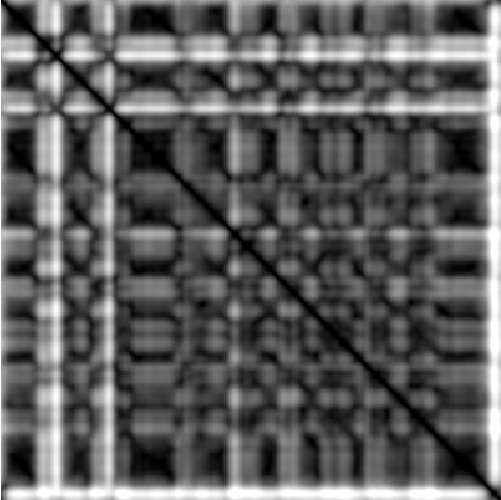22. Mut. (Courage)

Variiertes Strophenlied in g-Moll mit drei Strophen. [more]
Magnitude spectogram (3 sec) weighted by amount of rapid phase changes. [more]
Singer: Randall Scarlata (Baritone), Piano: Jeremy Denk. Recording of a performance at the Isabella Stewart Gardner Museum, Boston.
Source, License: CC BY-NC-ND 2.0
Information about our segmentation of »22. Mut«
Variiertes Strophenlied in g-Moll mit drei Strophen.
Die Segmentierung entspricht im Wesentlichen der Stropheneinteilung.
Das Vor-, Zwischen- und Nachspiel sind identisch.
Es lassen sich zwei Strophenarten unterscheiden: A und B.
Diese weisen untereinander starke melodische und leichte harmonische Unterschiede auf.
Die Rhythmik bleibt sowohl in der Gesangs- als auch in der Klavierstimme weitestgehend gleich.
Sowohl A als auch B1 und B2 sind zweiteilig aufgebaut und bestehen aus zwei Wiederholungen eines 6-7 taktigen Motivs.
Die zweiten Wiederholungen weichen jeweils leicht von dem Original ab.
Lyrics: Project Gutenberg
MFCC (Mel Frequency Cepstral Coefficients)
This feature was originally developed for speech analysis and speaker recognition. After transforming a musical signal in a spectrogram representation, MFCC-based features are computed by combining suitable frequency bands into percepually inspired Mel bands and applying a decorrelating discrete cosine transformation. Especially, the lower MFCC bands describe the coarse form of the spectral envelope which correlates to timbre. For deriving MFCC-ENS features (MFCC Energy Normalized Statistics), these MFCC features are quantized, smoothed (in temporal direction), and normalized with respect to the ℓ2-norm.
Furthermore, we present a novel variant of MFCC-ENS features by prior weighting the spectrogram by the second derivative of the spectral phase information in the time domain. This indicates slight changes in pitch which typically occur in vocals and which are not present in piano music. Especially the harmonics of piano-played notes are attenuated by this method which leads to smaller spectral envelopes in the piano sections and hence to more discriminative timbre-related MFCC features.
Literature
- Steven Davis, Paul Mermelstein: Comparison of parametric representations for monosyllabic word recognition in continuously spoken sentences, Readings in Speech Recognition 1990, pp. 65–74.
- Hiroko Terasawa, Malcolm Slaney, Jonathan Berger: The thirteen colors of timbre, WASPAA 2005, pp. 323–326.
- Dirk v. Zeddelmann, Frank Kurth: A construction of compact MFCC-type features using short-time statistics for applications in audio segmentation, EUSIPCO 2009, pp. 1504–1508.
